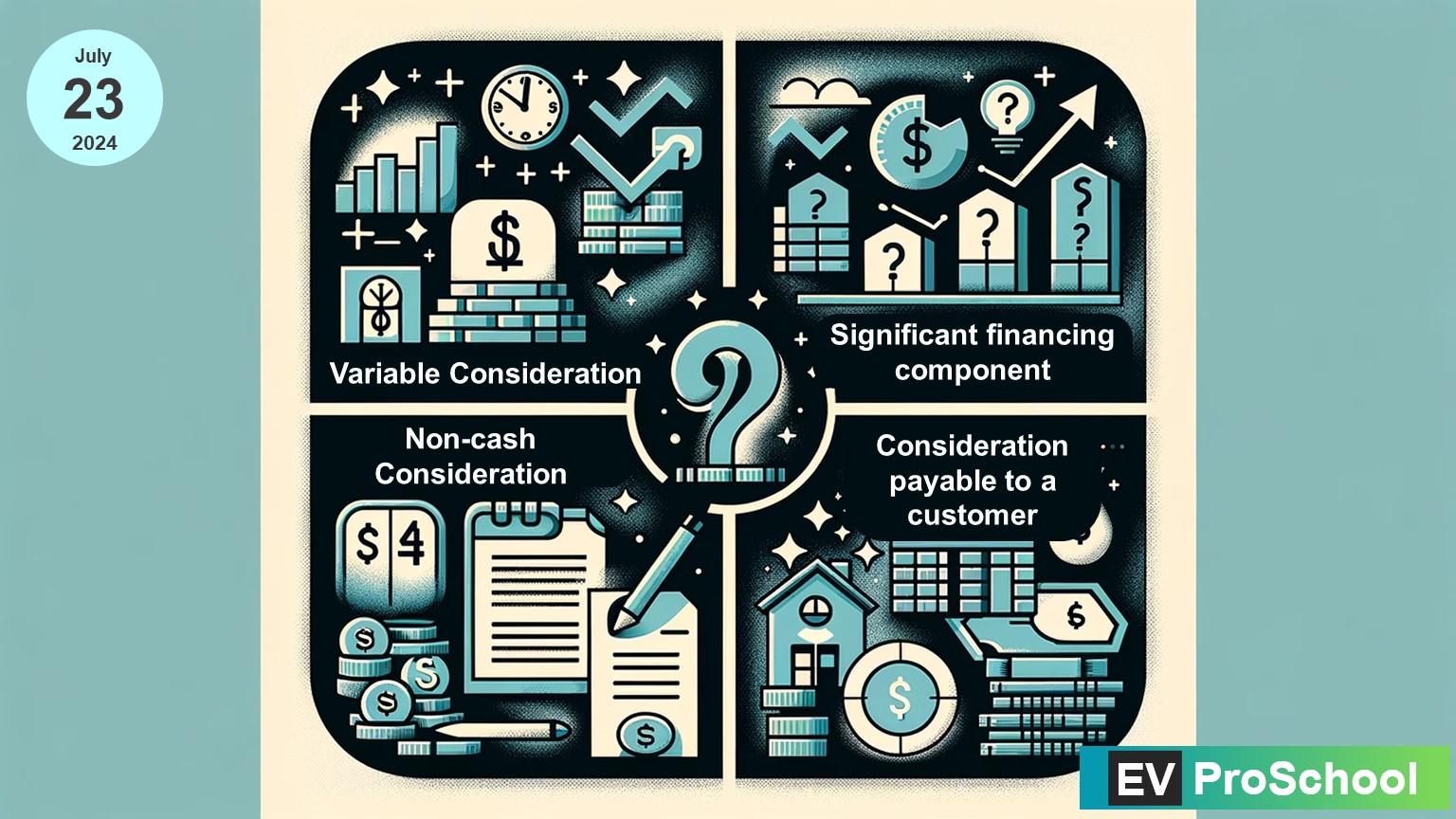The intricacies of revenue recognition within the electric vehicle (EV) sector can often feel like navigating through a complex circuitry. For OEMs in the Indian market, determining the transaction price — the total amount expected from sales of goods and services — plays a pivotal role in financial reporting. This process becomes particularly nuanced when dealing with variable consideration, like warranty provisions.
The Transaction price is a amount of consideration to which an entity is expected to entitled in exchange of promise goods & services to customer, excluding amount gathered from 3rd parties (Ex sales taxes)
Example from an Electric Vehicle
Let’s create a sales invoice for ElectraDrive, an EV manufacturer, detailing the sale of digital clusters for their vehicles. This example will help illustrate how to determine the transaction price, including the impact of taxes such as GST (Goods and Services Tax).
Sales Invoice
| Item No. | Description | Quantity | Rate (₹) | Value (₹) |
|---|---|---|---|---|
| 001 | Electric Vehicle Digital Cluster | 10 | 15,000 | 1,50,000 |
| 002 | Additional Charges (GST @ 18%) | 10 | 2700 | 27,000 |
| 003 | Total Invoice Value | 177,000 |
Explanation:
The sales invoice lists the sale of 10 electric vehicle digital clusters at a rate of ₹15,000 each, amounting to a total value of ₹150,000. An 18% GST applies to the items purchased, adding ₹27,000 to the total. Therefore, the total invoice value amounts to ₹177,000.
Determining the Transaction Price:
The transaction price in this scenario is the amount ElectraDrive expects to be entitled to in exchange for the digital clusters, which includes the base price of the clusters Therefore, the transaction price is ₹1,50,000.
When determining the transaction price, an entity shall consider the effects of all of the following.
- Variable consideration
- The existence of a significant financing component in the contract
- Non-cash consideration
- Consideration payable to a customer
1. Understanding Variable Consideration
Variable consideration under IFRS 15 involves payments that can change based on future events. These may include bonuses, discounts, refunds, credits, incentives, and, notably, warranties. Accounting for this variability hinges on the likelihood of certain outcomes and their financial impact.
Variable Consideration: The Warranty Scenario
Consider an Indian OEM, ElectraDrive, which sells an EV inclusive of a 4-year warranty for an additional ₹25,000, indirectly factored into the car’s price. This warranty is more than just a service; it’s a promise that could affect the transaction price based on future claims.
If warranty claims stay below 2%, ElectraDrive is entitled to an extra 25% on the warranty revenue, translating to a significant consideration beyond the initial ₹25,000.
Accounting Treatment: Two Scenarios
Case 1: Established OEM with a Proven Track Record
ElectraDrive has a history of low warranty claims, consistently under 2%. This historical data allows the company to predict similar outcomes confidently.
Accounting Treatment:
- Revenue Recognition: ElectraDrive recognizes the ₹25,000 from the warranty as part of the transaction price at the point of sale, alongside the car’s price.
- Variable Consideration: Given the probable outcome of claims staying below 2%, ElectraDrive can also recognize the additional 25% of warranty revenue upfront, adjusting this estimate as necessary in future periods.
Case 2: Launching an EV with New Technology:
With the introduction of a new motor technology, there’s an increased risk of warranty claims potentially reaching 5%.
Accounting Treatment:
- Revenue Recognition: The initial ₹25,000 is recognized as part of the transaction price at the sale.
- Variable Consideration: Due to the higher uncertainty, the additional 25% revenue cannot be recognized until it’s highly probable that a significant revenue reversal will not occur. This conservative approach protects against overestimating revenue.
Variable Consideration: Sale with Right to Return
When a customer purchases a product but retains the right to return it under certain conditions, the company cannot consider the entire sales revenue as earned immediately. This is because the final transaction amount depends on how many products are actually kept by customers versus those returned.
To address this, companies must estimate the amount of products likely to be returned and recognize revenue only for the amount that is “highly likely” not to be returned. Concurrently, they must establish a refund liability for the estimated returns, reflecting the obligation to return funds to customers for any returned products.
Example: Electric Vehicle (EV) Battery Sales with a Return Option
Scenario:
An EV manufacturer, ElectraVolt, sells a new line of EV batteries with a unique guarantee: customers can return the battery within a year if it fails after 10,000 km of use. Based on historical data and predictive analytics, ElectraVolt estimates that 95% of the sold batteries will not be returned under this policy.
Problem:
ElectraVolt sells 1,000 batteries at ₹10,000 each. With a right to return, how should ElectraVolt recognize revenue and record the refund liability?
Solution:
- Total Sales Revenue: 1,000 batteries x ₹10,000 = ₹10,000,000
- Estimated Returns: Based on the estimate that 95% of the batteries will not be returned, the likelihood of returns is 5%.
- Revenue Recognition: ElectraVolt should recognize revenue for the sales that are highly likely not to be returned. This equates to 95% of the total sales revenue.
- Revenue to be recognized: 95% of ₹10,000,000 = ₹9,500,000
- Refund Liability: For the estimated returns, ElectraVolt must establish a refund liability.
- Refund liability (5% of total sales): 5% of ₹10,000,000 = ₹500,000
Accounting Entries upon Sell:
- Debit Cash ₹10,000,000;
- Credit Revenue ₹9,500,000;
- Credit Refund Liability ₹500,000
This treatment ensures that ElectraVolt only recognizes the revenue it expects to retain after accounting for the estimated product returns, maintaining compliance with IFRS 15 and reflecting a more accurate financial position.
2. The Significant financing component
In the realm of revenue recognition, the significant financing component emerges when there is a notable time gap between the delivery of goods or services and the payment. This gap, especially when it spans 12 months or more, implies that either the customer is receiving a financing benefit (if they pay later) or the entity is receiving one (if paid in advance). Essentially, this aspect recognizes that money has a time value.
Example: EV Microchip Industry Scenario
Imagine a company, MicroVolt Technologies, specializing in high-performance microchips for electric vehicles (EVs). MicroVolt enters into a contract with an EV manufacturer, EcoDrive Innovations, to supply a specific type of microchip crucial for the EV’s battery management system. Due to production lead times and the strategic importance of these microchips, EcoDrive agrees to pay for the chips in 18 months, well after receiving them. The contract states the price for the microchips is ₹50 million, but if EcoDrive were to pay immediately, the cash selling price would be ₹47 million, reflecting a discount for immediate payment.
Identifying the Financing Component:
Given the 18-month delay in payment, there’s a clear financing component to this transaction. EcoDrive benefits from deferring payment, essentially receiving financing from MicroVolt. The difference between the transaction price (₹50 million) and the cash selling price (₹47 million) indicates the interest element associated with this financing.
Accounting Entries at Time of Sale:
- Debit Accounts Receivable: ₹50 million (SOFP)
- Credit Revenue (for microchips): ₹47 million (SOPL)
- Credit Interest Revenue (to be recognized over 18 months): ₹3 million (SOPL)
In the Statement of Profit or Loss (SOPL):
- Revenue from sale of goods: ₹47 million
- Interest income (over 18 months): Part of the ₹3 million as it accrues
- Revenue Recognition: The initial recognition of revenue at the time of transferring the goods, which in this case is the cash selling price of ₹47 million, will be reported in the SOPL. This reflects the income earned from the sale of microchips to EcoDrive Innovations.
- Interest Revenue: Over the 18-month period, the financing component of ₹3 million recognized as interest will also be reported in the SOPL but under financial income. This interest accrues due to the delayed payment and represents the financing service provided by MicroVolt to EcoDrive.
In the Statement of Financial Position (SOFP):
- Accounts Receivable: Initially at ₹50 million, adjusted for payments and recognition of interest income over time
- Interest Receivable: Represents the accrued interest income from the financing component not yet received
- Accounts Receivable: The total transaction price of ₹50 million, which is due in 18 months, will be recognized as an accounts receivable in the SOFP at the contract inception. This represents EcoDrive’s obligation to pay MicroVolt for the microchips received.
- Interest Receivable: The portion of the interest revenue that is accrued but not yet received by the end of the reporting period will be shown as interest receivable in the SOFP. This is part of the broader accounts receivable but specifies the amount attributable to the financing component.
- Revenue Recognition Adjustment: As the interest income is recognized over the period, the accounts receivable balance will decrease, not only from payments made by EcoDrive but also as the interest component is gradually recognized in the SOPL. This decreases the accounts receivable in the SOFP and increases cash or cash equivalents, reflecting the inflow from realized interest revenue.
3. Non-Cash Consideration Explained
Non-cash consideration involves transactions where a company receives goods, services, or other non-monetary assets in exchange for its goods or services, rather than traditional cash payments. According to IFRS 15, when determining the transaction price, an entity must consider the fair value of non-cash consideration received or receivable.
Non-cash consideration can take various forms, such as property, plant, equipment, other goods, services, or equity instruments. The key is that these items have value and can be measured reliably. The fair value of the non-cash consideration is included in the transaction price and, consequently, in revenue recognition.
Example in the Electric Vehicle (EV) Industry:
ElectraPower, a company specializing in electric vehicle charging solutions, enters into an agreement with AutoInnov, an EV manufacturer. Instead of paying cash, AutoInnov agrees to provide ElectraPower with 1,000 shares of its stock, valued at ₹500 per share, in exchange for installing advanced charging stations at multiple AutoInnov dealership locations.
Details of the Non-Cash Consideration:
- Consideration Received: 1,000 shares of AutoInnov stock
- Fair Value of Shares: ₹500 per share
- Total Fair Value: 1,000 shares x ₹500/share = ₹500,000
Accounting Treatment:
- Determine the Fair Value: ElectraPower assesses the fair value of the AutoInnov shares at the contract’s inception, which amounts to ₹500,000.
- Revenue Recognition: ElectraPower recognizes revenue of ₹500,000, reflecting the fair value of the non-cash consideration (AutoInnov shares) received in exchange for the charging stations installed.
Entries:
- Upon Installation Completion:
- Debit: Investment in AutoInnov Shares ₹500,000
- Credit: Revenue ₹500,000
This treatment aligns with the principle that revenue recognized should represent the amount the entity expects to be entitled to in exchange for the promised goods or services.
4. Consideration Payable to a Customer
Consideration payable to a customer involves instances where a company commits to transferring some amount of cash or other items of value to a customer. This can be part of a purchase agreement, a business incentive, a rebate, or a discount on future purchases. According to IFRS 15, when determining the transaction price, an entity must consider any amounts payable to a customer as a reduction of the transaction price and, consequently, revenue, unless the payment is for a distinct good or service that the customer is providing to the entity.
Understanding the distinction between “distinct” and “non-distinct” goods and services is crucial under IFRS 15 for revenue recognition purposes. This distinction helps determine whether goods or services should be accounted for as separate performance obligations.
Distinct Goods and Services
A good or service is considered “distinct” within the context of a contract if both of the following criteria are met:
- The customer can benefit from the good or service either on its own or together with other resources that are readily available to the customer. Essentially, the good or service can fulfill its intended function, provide its intended benefit, or be used as the customer would expect, without requiring significant integration service from the seller or modification of another good or service.
- The promise to transfer the good or service to the customer is separately identifiable from other promises in the contract. This means that the good or service is not highly interrelated with or dependent on other goods or services in the contract.
Example of Distinct Goods and Services:
VoltTech sells an EV battery to GreenMotors, which can be installed in GreenMotors’ vehicles. Along with the battery, VoltTech offers a one-time installation service. The battery is a distinct good because GreenMotors can benefit from it independently once installed. The installation service is also distinct because it does not significantly modify or customize the battery—it merely ensures the battery is properly installed in the vehicle.
Non-Distinct Goods and Services
Non-distinct goods or services do not meet the above criteria. They often require significant integration service with other goods or services in the contract to provide the intended benefit or cannot be separated from other promises in the contract due to their interrelated nature.
- Goods or services that are not capable of being distinct: These are goods or services that the customer cannot benefit from unless they are used in conjunction with other goods or services specified in the contract.
- Goods or services that are not separately identifiable: This typically involves goods or services that are so highly integrated and interdependent that they essentially form a single combined output.
Example of Non-Distinct Goods and Services:
Imagine ElectraDrive offers a comprehensive mobility solution that includes an EV, a proprietary charging system that requires custom integration with the vehicle, and a software subscription for navigation and vehicle diagnostics. The charging system and software are not distinct within the context of this contract because they are designed to work specifically with ElectraDrive’s vehicle and require significant integration and customization. Therefore, they would be considered as a bundle of non-distinct goods and services that form a single performance obligation.
Here we come to end & conclude the Step 3: Determine the Transaction Price. In next blogpost lets delve into the Step 4 & 5.
- Identify the Contract(s) with a customer.
- Identify the Performance Obligations in the contract.
- Determine the transaction Price.
- Allocate the transaction price to the performance obligations in the contract.
- Recognize revenue when (or as) the entity satisfies a performance obligation.
Conclusion
In the intricate financial landscape of IFRS 15, navigating the components of transaction prices is akin to steering through the dynamic currents of the electric vehicle (EV) industry. Our exploration into variable consideration, significant financing components, non-cash consideration, and consideration payable to customers illuminates the multifaceted approach required to accurately recognize revenue. Each component, with its unique characteristics and implications, plays a critical role in ensuring that revenue is recorded in a manner that truly reflects the economic reality of a transaction.
From the variable unpredictability of warranty claims in ElectraDrive’s scenario to the strategic financing behind extended payment terms, the depth of IFRS 15’s guidelines is evident. These components, while complex, offer a framework for companies to navigate the financial nuances of their transactions, ensuring clarity, compliance, and confidence in financial reporting.



